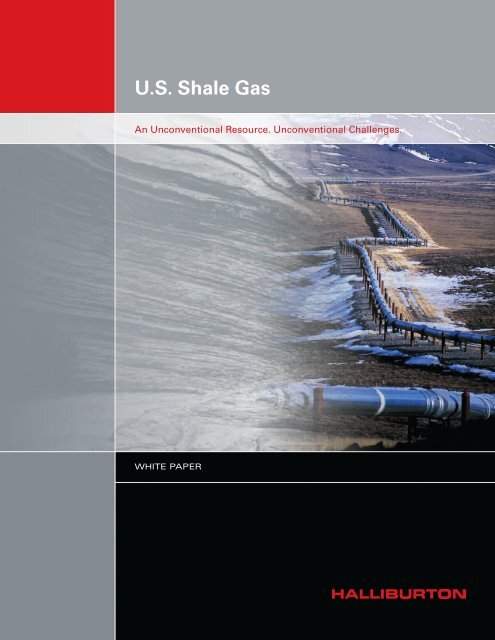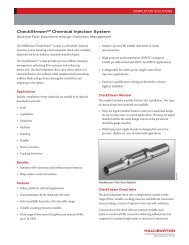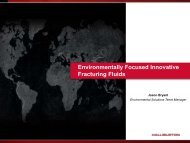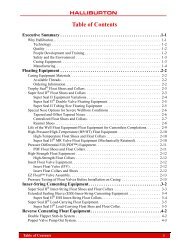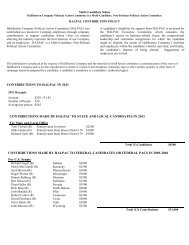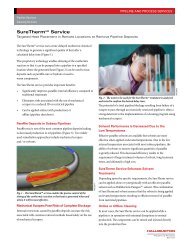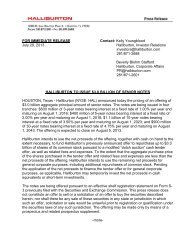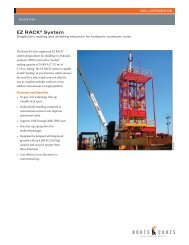U.S. Shale Gas - Halliburton
U.S. Shale Gas - Halliburton
U.S. Shale Gas - Halliburton
Create successful ePaper yourself
Turn your PDF publications into a flip-book with our unique Google optimized e-Paper software.
U.S. <strong>Shale</strong> <strong>Gas</strong><br />
An Unconventional Resource. Unconventional Challenges.<br />
WHITE PAPER
U.S. <strong>Shale</strong> <strong>Gas</strong><br />
An Unconventional Resource. Unconventional Challenges.<br />
Executive Summary<br />
Current increasing demand and lagging supply mean high prices for both oil and gas, making<br />
exploitation of North American unconventional gas plays suddenly far more lucrative for<br />
producers. One of the most important such plays to emerge has been U.S. shale gas, with<br />
current recoverable reserves conservatively estimated at 500 to 1,000 trillion cubic feet.<br />
Hydraulic fracturing and horizontal drilling are the key enabling technologies that first made<br />
recovery of shale gas economically viable with their introduction in the Barnett <strong>Shale</strong> of Texas<br />
during the 1990s. However, a comparison of the currently hottest shale plays makes it clear<br />
that, after two decades of development and several iterations of the learning curve, best<br />
practices are application-dependent and must evolve locally.<br />
That said, a review of current trends in these hot plays indicates that, in many cases, the<br />
impact of high-drilling density required to develop continuous gas accumulations can be<br />
minimized through early and better identification of the accumulation type and size, welldesigned<br />
access and transportation networks, and cooperative planning and construction<br />
efforts, when possible.<br />
U.S. <strong>Shale</strong> <strong>Gas</strong> Geographic Potential<br />
Across the U.S., from the West Coast to the Northeast, some 19 geographic basins are<br />
recognized sources of shale gas, where an estimated 35,000 wells were drilled in 2006.<br />
Presently, significant commercial gas shale production occurs in the Barnett <strong>Shale</strong> in the<br />
Fort Worth Basin, Lewis <strong>Shale</strong> in the San Juan Basin, Antrim <strong>Shale</strong> in the Michigan Basin,<br />
Marcellus <strong>Shale</strong> and others in the Appalachian Basin, and New Albany <strong>Shale</strong> in the<br />
Illinois Basin.<br />
But it wasn’t always so.<br />
Lacking an efficient means of production, U.S. shale gas reserves were largely ignored so long<br />
as market conditions made reserves more costly to produce than conventional sources. In fact,<br />
one of the first recognized major shale gas plays, the Barnett <strong>Shale</strong> of Texas, was under<br />
investigation as early as 1981, but not until 1995 was the hydraulic fracturing technology<br />
available that successfully brought in the gas at commercial rates. Then, five of the initial six<br />
wells each began producing more than two million cubic feet of gas per day and, soon after,<br />
introduction of horizontal drilling began to extend the basin where today two percent of all<br />
the gas consumed daily in the U.S. is produced.<br />
1
2<br />
Evolution of a <strong>Shale</strong> Play<br />
Typically, exploitation of a shale play proceeds through three distinct phases, from the discovery stage,<br />
through drilling and reservoir evaluation, to production.<br />
Discovery and planning is the stage during which all of the initial reservoir knowledge is gathered. Extensive<br />
analysis including coring establishes the economic viability of the play during this phase, and helps determine<br />
the techniques to be used to optimize the development. The effectiveness of planning accomplished in the<br />
discovery stage depends largely upon knowledge of the reservoir.<br />
Drilling and reservoir evaluation is the operational phase. During this stage, the focus is on applying the<br />
planned techniques most efficiently to maximize reservoir contact and lower cost per unit. It is in this stage of<br />
development that the issues concerning infrastructure and practical efficiencies are addressed. And this is the<br />
present state of several currently hot shale plays.<br />
Production phase focuses on optimizing reservoir drainage, which in U.S. shale gas plays typically requires<br />
stimulation, usually by hydraulic fracturing. The efficiency of these completion operations can have significant<br />
impact during the production phase; with proper fracturing and placement of proppants, some shale wells<br />
have been producing for decades.<br />
The Problem with <strong>Shale</strong><br />
Despite its geographic abundance and enormous production potential, gas shale presents a number of<br />
challenges – starting with the lack of an agreed-upon definition of what, exactly, comprises shale.<br />
<strong>Shale</strong> makes up more than half the earth’s sedimentary rock but includes a wide variety of vastly differing<br />
formations. Within the industry, the generally homogenous, fine-grained rock can be defined in terms of its<br />
geology, geochemistry, geo-mechanics and production mechanism – all of which differ from a conventional<br />
reservoir, and can differ from shale to shale, and even within the same shale. Little wonder there is no<br />
industry-standard definition.<br />
Nevertheless, all shale is characterized by low permeability, and in all gas-producing shales, organic carbon in<br />
the shale is the source. Many have substantial gas stored in the free state, with additional gas storage capacity<br />
in intergranular porosity and/or fractures. Other gas shales grade into tight sands, and many tight sands have<br />
gas stored in the adsorbed state.<br />
Since these various conditions determine the production mechanism of the various shales, knowledge of local<br />
reservoir characteristics is of vital importance in keeping development costs under control and optimizing<br />
production over the life of the reservoir.<br />
Every <strong>Shale</strong> is Different<br />
Due to the unique nature of shale, every basin, play, well and pay zone may require a unique treatment. Briefly<br />
comparing the characteristics of some of the current hottest plays can help illustrate the impact of these<br />
differences throughout development.
The Barnett <strong>Shale</strong>: Setting the Standard<br />
With current assets still exceeding an estimated 10 trillion cubic feet, the spectacular success in the Barnett in 1995<br />
established the economic potential of U.S. shale gas production and set the standard for subsequent development in<br />
other basins.<br />
Horizontal drilling and hydraulic fracturing are the key enabling technologies that first made recovery of Barnett shale gas<br />
economically viable in the mid-1990s. Today, completion and drilling techniques are well established there, and drilling<br />
efficiencies continue to improve even as laterals extend to increasing lengths. A typical lateral is 2,500 feet to 3,000 feet. Use<br />
of water-based muds is standard, as is cementing with acid soluble cement. A typical Barnett completion is Tubing Conveyed<br />
Perforating toe then fracturing in stages using pump-down plugs and guns.<br />
In addition to drilling longer laterals, current trends in the Barnett are toward bigger frac jobs and more stages. Infills are<br />
being drilled and testing of spacing is down to 10 acres, while re-fracturing of the first horizontal wells from 2003 and 2004<br />
has commenced; both infills and refracs are expected to improve Estimated Ultimate Recovery from 11 percent to 18<br />
percent. In addition, pad drilling, especially in urban areas, and recycling of water are growing trends in the Barnett,<br />
as elsewhere.<br />
The Woodford <strong>Shale</strong> – Oklahoma<br />
Woodford shale stratigraphy and organic content are well understood, but due to their complexity compared to the Barnett<br />
shale, the formations are more difficult to drill and fracture. Because shales have the most elements and chemostratigraphic<br />
information to work with, they are more easily analyzed than most sandstone and carbonate reservoirs and can be<br />
Chemosteered with unprecedented resolution using LaserStrat® services.<br />
As in the Barnett, horizontal wells are drilled, although oil-based mud is used in the Woodford and the formation is harder<br />
to drill. In addition to containing chert and pyrite, the Woodford play is more faulted, making it easy to drill out of the<br />
interval; sometimes crossing several faults in a single wellbore is required. <strong>Halliburton</strong> geosteering techniques in<br />
combination with logging while drilling tools can minimize this risk.<br />
Like the Barnett shale, higher silica rocks are predominant in the best zones for fracturing in the Woodford play, although<br />
the Woodford has deeper and higher frac gradients.<br />
ZoneSeal® cement has significantly improved the success rate of frac jobs here, although acid and/or sand slugs are<br />
sometimes required to gain entry.<br />
Due to heavy faulting, 3-D seismic is extremely important, as the Woodford trends toward longer laterals exceeding 3,000<br />
feet with bigger frac jobs and more stages. Testing infill pilots has begun, as well as some simultaneous-frac jobs. Pad<br />
drilling also will increase as the Woodford continues expanding to the Ardmore Basin and to West Central Oklahoma in<br />
Canadian County.<br />
Monterey<br />
Green River<br />
Cane Creek<br />
Gammon<br />
Lewis / Mancos<br />
Niobrara<br />
Woodford / Caney<br />
Barnett<br />
Bakken<br />
Fayetteville<br />
New Albany<br />
Haynesville /<br />
Bossier<br />
Floyd<br />
Antrim<br />
Conasauga<br />
Devonian<br />
Marcellus<br />
3
4<br />
The Haynesville <strong>Shale</strong> – East Texas /<br />
Northwestern Louisiana<br />
Still in the early discovery stage, the Haynesville shale<br />
environment already has proved especially challenging.<br />
Compared to the Barnett, the Haynesville is extremely<br />
laminated, and the reservoir changes over intervals as<br />
small as four inches to one foot. In addition, at depths of<br />
10,500 to 13,500 feet, this play is deeper than typical<br />
shales creating hostile conditions. Average well depths are<br />
11,800 feet with bottomhole temperatures averaging<br />
300°F and wellhead treating pressures that exceed 10,000<br />
psi. As a result, wells in the Haynesville require almost<br />
twice the amount of hydraulic horsepower, higher<br />
treating pressures and more advanced fluid chemistry<br />
than the Barnett and Woodford shales.<br />
The high-temperature range, from 260°F to 380°F, creates<br />
additional problems in Haynesville’s horizontal wells,<br />
requiring rugged, high-temperature/high-pressure<br />
logging evaluation, Toolpusher and LWD tools. For<br />
these conditions, the availability of SOLAR tools from<br />
Sperry Drilling Services has proved a plus, particularly<br />
as logistics issues begin to emerge.<br />
Already, there are issues with availability of casing and<br />
proppant supplies as producers increase demand under<br />
pressure to complete wells before their leases expire. The<br />
majority of Haynesville leases are held for just three years,<br />
and with acreage leasing for up to $25,000 per acre,<br />
producers are concerned about their ability to drill<br />
in time.<br />
Durable high-horsepower pumping equipment will be<br />
required to effectively fracture stimulate the Haynesville.<br />
<strong>Halliburton</strong> is positioned to provide the maximum<br />
horsepower necessary in these types of formations.<br />
Additionally, <strong>Halliburton</strong>’s pump reliability is well<br />
established in the industry. The formation depth and<br />
high-fracture gradient demand long pump times at<br />
pressures above 12,000 psi. In these deep wells, with<br />
fracture gradients of one psi/ft, and low Young’s<br />
modulus, there is also concern about the ability to<br />
sustain production with adequate fracture conductivity.<br />
Currently, Haynesville wells are being drilled with oilbased<br />
muds, and as the trend continues toward increased<br />
activity, environmental issues will come to the fore. The<br />
estimated 115-plus rigs that will be drilling this play will<br />
require large volumes of water for fracturing, making<br />
water conservation and disposal a primary issue.<br />
The Bakken <strong>Shale</strong> – Williston Basin<br />
The Bakken differs from other shale plays in that it is an<br />
oil reservoir, a dolomite layered between two shales, with<br />
depths ranging from around 8,000 to 10,000 feet. Oil, gas<br />
and natural gas liquids are produced.<br />
Each succeeding member of the Bakken formation –<br />
lower shale, middle sandstone and upper shale member –<br />
is geographically larger than the one below. Both the<br />
upper and lower shales, which are the petroleum source<br />
rocks, present fairly consistent lithology, while the middle<br />
sandstone member varies in thickness, lithology and<br />
petrophysical properties.<br />
Currently, Bakken oil wells are completed either<br />
openhole or with uncemented liners, and the use of<br />
isolation tools such as <strong>Halliburton</strong> Delta Stim® sleeves<br />
and Swellpacker® systems is extensive. The Bakken is not<br />
as naturally fractured as the Barnett and, therefore,<br />
requires more traditional frac geometries with both<br />
longitudinal and transverse fractures. Diversion methods<br />
are used throughout hydraulic frac treatments, which<br />
primarily use gelled water frac fluids, although there is a<br />
growing trend toward the use of Intermediate Strength<br />
Proppant. Compared to the Barnett, rate treatments in<br />
the Bakken typically are lower – from 30 to 50 bpm –<br />
with openhole completions requiring higher rates.<br />
Recently, the Bakken has seen an increase in activity, and<br />
the trend is, again, toward longer laterals – up to 10,000<br />
feet for single laterals in some cases. In addition, some<br />
operators are drilling below the lower Bakken shale and<br />
fracturing upwards.
The Fayetteville <strong>Shale</strong> – Arkoma Basin<br />
With productive wells penetrating the Fayetteville shale<br />
at depths between a few hundred and 7,000 feet, this play<br />
is somewhat shallower than the Barnett. Mediocre<br />
production from early vertical wells stalled development<br />
in the vertically fractured Fayetteville, and only with<br />
recent introduction of horizontal drilling and hydraulic<br />
fracturing has drilling activity increased. As a result, at<br />
present there is less oilfield infrastructure in place in the<br />
Fayetteville than in other hot plays.<br />
In the most active Central Fayetteville <strong>Shale</strong>, horizontal<br />
wells are drilled using oil-based mud in most cases,<br />
and water-based mud in others. Most wells now are<br />
cemented, but the current trend is toward using tools<br />
such as <strong>Halliburton</strong>’s Delta Stim® sleeves and Swellpacker®<br />
systems technology in openhole completions. In<br />
addition, 3-D seismic will gain importance as longer<br />
laterals of 3,000-plus feet are drilled and more stages are<br />
required for fracing. With growing numbers of wells and<br />
a need for more infrastructure, pad drilling is another<br />
trend emerging in the Fayetteville.<br />
Summary<br />
The Marcellus <strong>Shale</strong> – Appalachian Basin<br />
Currently the hottest play in the 54,000-square mile<br />
Appalachian Basin, the Marcellus formation is not a new<br />
discovery. Prior to 2000, this low-density, vertically<br />
fractured shale formation was explored with a number<br />
of successful vertical gas wells, many of which have<br />
produced – slowly but surely – for decades. However, not<br />
until the 2000 introduction of techniques pioneered in<br />
the Barnett shale, did Marcellus wells begin to yield<br />
significantly improved production rates.<br />
The Marcellus shale ranges in depth from 4,000 to 8,500<br />
feet, with gas currently produced from hydraulically<br />
fractured horizontal wellbores. Horizontal lateral lengths<br />
exceed 2,000 feet, and, typically, completions involve<br />
multistage fracturing with more than three stages<br />
per well.<br />
To date, the heavy leasing activity has occurred primarily<br />
in one small geographic area where the thick shale can be<br />
drilled at minimum depths. As a result, the Marcellus<br />
play is still in the exploration stage, with trends toward<br />
inevitably deeper wells, longer laterals and more stages.<br />
As these brief comparisons suggest, at every step of development in every shale gas play, best<br />
practices are application-dependent and must evolve to meet specific, local challenges. As<br />
techniques are refined and local best practices emerge, it remains to be seen if the rising star of<br />
the Barnett play will be eclipsed by these other up-and-coming shale gas plays.<br />
5
Conclusions<br />
Unconventional Resources Require<br />
Unconventional Solutions<br />
As a source of abundant, high-quality natural gas, the potential of U.S. shale gas has<br />
only begun to be realized. While the challenges to producers may be significant— and<br />
significantly different from play to play—they are not insurmountable, providing the<br />
right technology and experience are on hand.<br />
While conventional horizontal directional drilling technologies have been used to drill<br />
shale gas wells, in almost every case, the rock around the wellbore must be hydraulically<br />
fractured before the well can produce significant amounts of gas, and the cost of<br />
fracturing horizontal wells can be as much as 25 percent of the total cost of the well.<br />
To keep development costs under control, there will be a need for improved exploration,<br />
production efficiencies and best practices that combine current knowledge and new<br />
approaches.<br />
In most cases, multiwell drilling can afford improved efficiencies in hydraulic frac<br />
stimulation operations, enhancing the percentage of recoverable gas to boost production<br />
rates over the economic threshold, while pad drilling of several multilateral wells from a<br />
single pad will further improve the economies-of-scale and help reduce location costs<br />
while generating a minimal environmental footprint.<br />
The unconventional challenges of shale gas drilling demand higher levels of service<br />
intensity. <strong>Halliburton</strong> is uniquely positioned to respond with integrated solutions for<br />
more productive and cost effective shale exploitation.<br />
Sales of <strong>Halliburton</strong> products and services will be in accord solely with<br />
the terms and conditions contained in the contract between <strong>Halliburton</strong><br />
and the customer that is applicable to the sale.<br />
H06377 07/08<br />
© 2008 <strong>Halliburton</strong>. All Rights Reserved.<br />
For more information contact us at:<br />
NA<strong>Shale</strong>@halliburton.com<br />
www.halliburton.com


